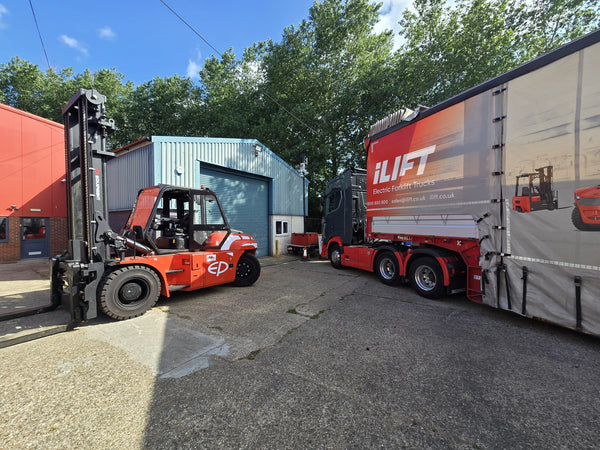The material handling industry stands at the cusp of a profound transformation, driven by the relentless advancement of battery technology. For decades, warehouses and distribution centres have relied on a familiar dichotomy: lead-acid batteries for electric forklifts and internal combustion (IC) engines for heavier-duty or outdoor tasks. However, a new contender, Lithium-Ion (Li-ion) battery technology, is rapidly dismantling this old order, emerging not just as an alternative, but as the definitive successor, promising a future of enhanced efficiency, reduced costs, and greater sustainability.
The shift is already palpable. Industry projections indicate a dramatic swing, with Li-ion powered electric forklifts expected to capture over 62% of new electric forklift sales in the U.S. by 2029, while the share of traditional lead-acid batteries is predicted to fall to just 33%. This isn't merely a trend; it's a technological migration, underpinned by a suite of compelling long-term benefits that businesses can no longer afford to ignore. This article delves into why Li-ion technology is not just improving forklift performance but is fundamentally reshaping the future of material handling.

The Heart of the Revolution: Understanding Lithium-Ion's Edge
At its core, Li-ion technology offers a more sophisticated and efficient way to store and deliver power. These batteries, often utilising Lithium Iron Phosphate (LFP or LiFePO4) chemistry for its enhanced safety and stability in demanding industrial applications , operate through the movement of lithium ions between an anode and a cathode. This fundamental design translates into several key characteristics that give Li-ion forklifts a distinct advantage.
Firstly, Li-ion batteries boast a significantly higher energy density than their lead-acid counterparts. This means they can pack more power into a smaller, often lighter, package, enabling longer runtimes and sustained performance. Secondly, they feature a much flatter discharge curve. Unlike lead-acid batteries that experience a noticeable drop in voltage and thus performance as they deplete , Li-ion batteries deliver consistent power output throughout the majority of their discharge cycle. This ensures that a forklift maintains its operational speed and lifting capability, enhancing productivity across an entire shift.
Lithium-Ion vs. Lead-Acid: A Paradigm Shift in Electric Power
For operations currently utilising lead-acid electric forklifts, the transition to Li-ion represents a monumental leap forward across virtually every operational metric.
1. Charging and Uptime – A New Era of Flexibility: The most transformative advantage lies in charging. Li-ion batteries can achieve a full charge in as little as 1-2 hours , a stark contrast to the 8-hour charge time plus an additional 8-hour cooling period required for lead-acid batteries. This 16-hour cycle for lead-acid effectively renders a single battery capable of powering only one shift per day.
Furthermore, Li-ion technology embraces opportunity charging. This allows batteries to be topped up during short breaks or any idle moment without harming the battery's lifespan. This capability often means a single Li-ion battery can power a forklift through multiple shifts or even 24/7 operations , eliminating the need for battery swapping, spare batteries, and the cumbersome changing equipment associated with lead-acid systems. Consequently, the requirement for dedicated, ventilated charging rooms – essential for lead-acid due to hazardous gassing – is also negated, freeing up valuable warehouse space.
2. Extended Lifespan – Built to Last: Li-ion batteries offer a significantly longer operational life, typically rated for 2,000 to 3,000 charge cycles, with some LFP variants reaching 3,500 or even 5,000 cycles. Lead-acid batteries, in comparison, generally provide around 1,500 cycles. This translates into a Li-ion battery lasting 5-10 years or more, compared to the typical 3-5 year lifespan of a lead-acid battery. This longevity drastically reduces the frequency and cost of battery replacements.
3. Minimal Maintenance – Slashing the Burden: The maintenance regimen for Li-ion batteries is virtually non-existent. Being sealed units, they require no regular watering, electrolyte checks, equalisation charges, or cleaning of corrosive acid residue. This contrasts sharply with the intensive, time-consuming, and costly upkeep demanded by lead-acid batteries.
4. Superior Performance and Efficiency – Consistent Power, Lower Costs: Li-ion batteries are significantly more energy-efficient, with charge efficiencies often up to 95-99% , compared to around 70-80% for lead-acid. This means more of the electricity used for charging is converted into productive work, leading to lower energy consumption and reduced electricity bills. Their flatter discharge curve also ensures consistent forklift performance, avoiding the slowdown experienced with lead-acid as they discharge.
5. Enhanced Safety and Environmental Profile: Sealed Li-ion units eliminate the risks of acid spills and the emission of flammable hydrogen gas during charging, common hazards with lead-acid batteries. This improves workplace safety and removes the need for specialised ventilated charging areas. While lead-acid batteries are widely recycled , their disposal involves handling hazardous materials like lead and sulfuric acid, and is subject to increasingly stringent regulations, such as those concerning Persistent Organic Pollutants (POPs) in battery casings in the UK. Li-ion battery recycling is a rapidly advancing field, with UK facilities like Recyclus achieving high recovery rates for valuable materials.
6. Total Cost of Ownership (TCO) – The Real Economic Winner: Despite a higher initial purchase price (a Li-ion battery can cost $17,000-$25,000 versus $5,000-$12,000 for lead-acid or £8,000-£15,000 versus £3,000-£5,000 ), the TCO for Li-ion forklifts is significantly lower. Savings accumulate from reduced energy consumption , eliminated maintenance labour and parts , longer battery lifespan , and increased productivity due to reduced downtime. Return on investment (ROI) is often seen within 2-3 years, especially in multi-shift operations.

Lithium-Ion vs. Internal Combustion: The Clean Sweep
The advantages of Li-ion extend robustly when compared against IC engine forklifts powered by diesel, LPG, or petrol.
1. Emissions and Workplace Quality – A Breath of Fresh Air: This is where Li-ion truly shines. Li-ion powered forklifts produce zero direct exhaust emissions (CO2, NOx, particulates). This dramatically improves air quality within facilities, crucial for employee health and in sensitive industries like food and pharmaceuticals. A diesel forklift can emit approximately 36 tonnes of CO2 over five years, compared to just 0.99 tonnes indirectly for an electric forklift (based on electricity generation). Li-ion units are also significantly quieter, reducing noise pollution and creating a less stressful, more productive work environment.
2. Maintenance and Fuel Costs – Leaner Operations: Electric forklifts, in general, have fewer moving parts than IC models, leading to substantially lower maintenance needs. Li-ion batteries themselves are virtually maintenance-free. IC engines, conversely, require regular oil changes, filter replacements, and other engine-specific upkeep. This translates to maintenance costs for Li-ion forklifts being up to 50% lower than for IC vehicles. Fuel costs also heavily favour Li-ion. Electricity is generally cheaper and more price-stable than diesel or LPG. Hourly operating costs for diesel forklifts can range from $8.50-$12.00, while Li-ion systems can operate at $1.20-$1.80 per hour, with energy costs reduced by 80-90%.
3. Operational Efficiency and Infrastructure: While IC forklifts offer rapid refuelling , Li-ion's opportunity charging often negates this advantage in terms of overall uptime. Charging infrastructure for Li-ion is generally simpler and requires less dedicated space than IC fuel storage tanks and refuelling stations, which are subject to stringent safety regulations. While IC engines have traditionally dominated heavy-duty outdoor applications , modern electric forklifts, including Li-ion models, are increasingly capable for outdoor use and in varied temperature conditions, including cold storage.
4. Total Cost of Ownership – The Clear Financial Winner: Even with a potentially higher initial outlay, the TCO for Li-ion electric forklifts consistently undercuts that of IC models. The combined savings from fuel, maintenance, and often longer operational lifespans lead to a compelling financial case. A UK-based company, Burton Roofing, switched its diesel fleet to Toyota electric forklifts, finding them considerably more cost-effective over five years, driven initially by rising diesel costs and regulatory changes regarding red diesel.
Navigating the Transition: Challenges and the Road Ahead
Despite the compelling case, the shift to Li-ion is not without its considerations. The higher initial investment remains a primary hurdle for some businesses, particularly smaller enterprises. However, as TCO benefits become more widely understood and leasing or financing options become more readily available , this barrier is diminishing.
Infrastructure and Design: Facilities may need to assess their electrical capacity for charging stations, although these are generally less demanding in terms of space and specialised ventilation than lead-acid charging rooms. Because Li-ion batteries are lighter than lead-acid, forklifts may require additional counterweighting if retrofitted, though purpose-built Li-ion forklifts leverage this lighter weight for improved design and ergonomics.
End-of-Life Management – A Greener Future: Concerns about Li-ion battery disposal are being actively addressed. The UK has a growing recycling infrastructure, with companies like Recyclus operating industrial-scale plants capable of recovering valuable materials like lithium, cobalt, and nickel from various Li-ion chemistries. Advanced processes, such as Altilium's EcoCathode technology, are achieving over 95% recovery rates. Furthermore, the concept of second-life applications is gaining traction, where batteries no longer suitable for demanding forklift operations (often retaining 70-80% capacity) can be repurposed for stationary energy storage, extending their usable life significantly.

Lithium-Ion Is Powering the Future
The evidence is overwhelmingly clear: Lithium-Ion technology is not just a fleeting trend but the cornerstone of the future of material handling. Its profound advantages in charging speed and flexibility, operational lifespan, maintenance reduction, energy efficiency, safety, and environmental impact deliver a significantly lower Total Cost of Ownership compared to both lead-acid and internal combustion alternatives.
The transition to Li-ion forklifts offers businesses a pathway to more productive, cost-effective, and sustainable operations. It aligns with the global push for electrification and decarbonisation, future-proofing operations against volatile fuel prices and tightening environmental regulations. As market adoption accelerates and the ecosystem for Li-ion battery management matures, the question for businesses is no longer if they should make the switch, but how quickly they can embrace this transformative technology to secure their competitive edge in the dynamic world of material handling.





